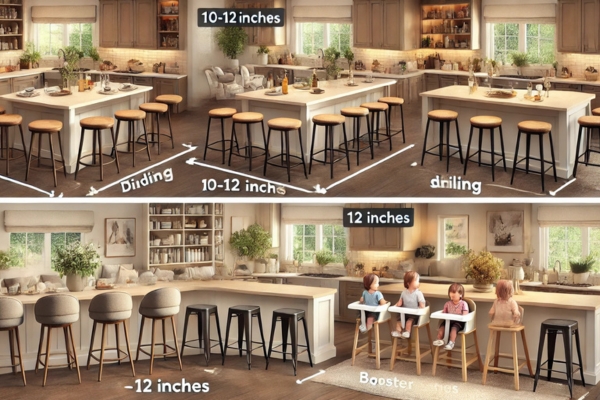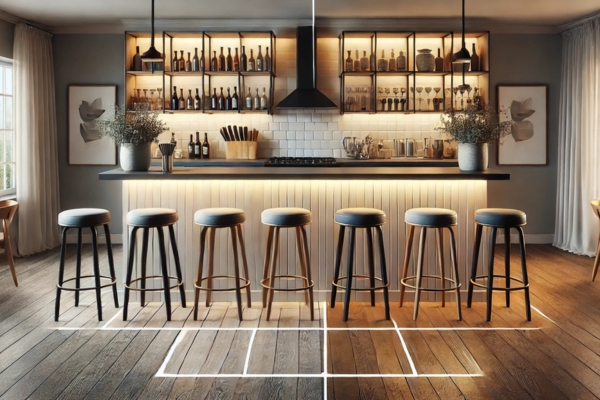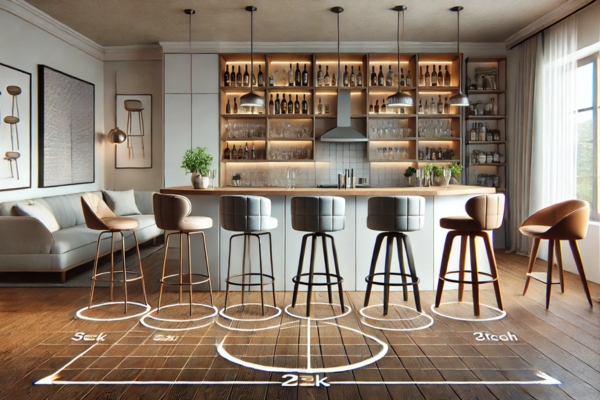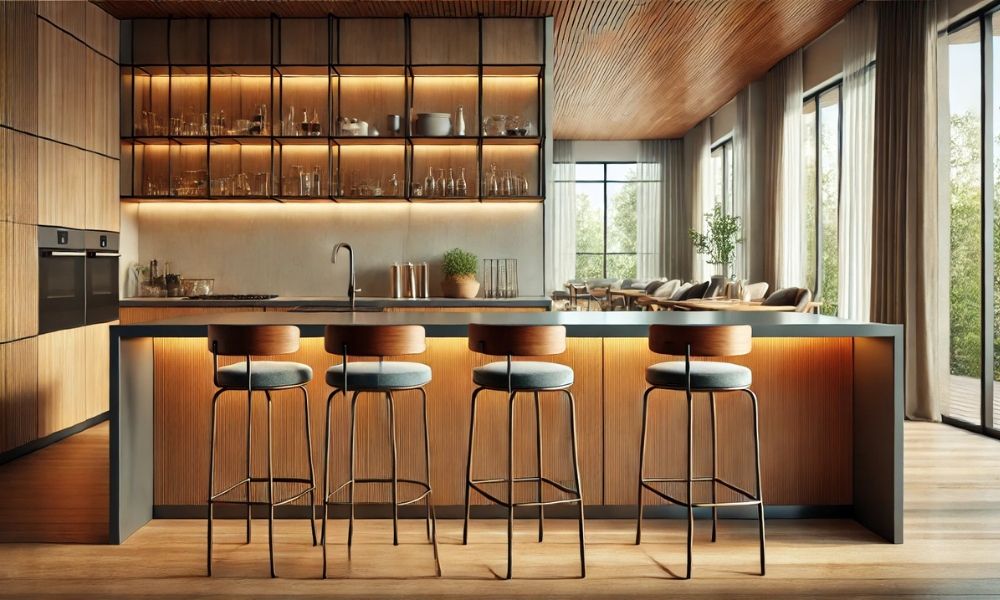Bar stools. They’re not just seating, are they? They’re statement pieces, adding structure and style to any well-curated kitchen, bar, or outdoor oasis. But, like all things in design, there’s a delicate balance. Too close, and your space feels crowded, stifling; too far, and it lacks connection. Striking the right balance, finding the perfect space between bar stools—this is where art meets science. In that sweet spot, functionality and aesthetics harmonize. It’s more than preference; it’s about creating an atmosphere where people feel at home, whether they’re sharing drinks or simply enjoying the ambiance.
Why The Right Spacing Between Bar Stools Matters
Spacing isn’t trivial; it’s a cornerstone of comfort and usability. Crowding stools together makes things awkward—no room to move, no room to breathe. Too much distance, though, and you lose that cozy, convivial vibe. A balanced arrangement makes a difference, transforming casual seating into a welcoming space. The right spacing invites conversation, making dining or socializing a relaxed, engaging experience.
Understanding The Impact Of Spacing On Comfort And Aesthetic
When it comes to bar stools, comfort and aesthetics are intertwined. Picture this: a bar where every guest has ample room to lean, reach, and stretch. That’s comfort, embodied. But it’s also about the bigger picture. Thoughtful spacing contributes to the visual flow, enhancing design themes, whether sleek and modern or rustic and relaxed. Proper spacing not only elevates the experience but enhances the entire room’s vibe.
Key Considerations Before Measuring Bar Stool Spacing
Types Of Bar Stools: Counter Vs. Bar Height
Bar stools come in various heights, with counter stools around 24-26 inches and High stools standing Tall Are Bar Height Stools, around 28-32 inches. This height disparity means different spatial needs. Taller chairs tend to command more space for comfortable seating, influencing how closely they can be placed without feeling cramped.
Factors That Influence Ideal Spacing
Several elements affect spacing: the width of the stools, the counter’s shape, and how you envision using the area. Are you aiming for a space that’s ideal for intimate dinners or one for relaxed gatherings over cocktails? The function of the area guides the space requirements—sometimes narrower, sometimes wider.
Understanding Bar Stool Width And Depth
Width and depth are fundamental. Extra-wide chairs, especially those with arms, demand more room. Depth is equally crucial for comfort; deeper seats encourage lounging but need additional clearance. It’s not just about fitting the stools—it’s about making sure they fit well.
Standard Spacing Guidelines For Bar Stools

The Ideal Distance Between Standard Bar Stools
A widely accepted rule is to maintain 6-10 inches between the edges of stools. This spacing offers comfort without feeling isolated. It keeps people close enough for interaction yet far enough for personal space.
How Much Space Between Extra-Wide Bar Stools
With broader stools, consider extending the distance to around 12 inches. This adjustment allows for easy sitting and standing, providing the space people need to feel at ease without jostling elbows or personal boundaries.
How Spacing Varies With Backless Vs. Stools With Backs
Backless chairs take up less space and can be placed closer together. They’re streamlined, unobtrusive. Stools with backs, however, offer support and a more defined presence, warranting extra room for comfort.
Measuring For Comfort: Space Around Each Bar Stool

Ensuring Enough Elbow Room
Elbow room is a must. Allow at least 24 inches per stool, measured from center to center. This spacing ensures minimal risk of accidental bumps, creating an inviting space for everyone to unwind.
Calculating Foot and Leg Room
Besides elbow room, don’t forget leg space. A depth of at least 10 inches between the stool and the counter edge keeps knees from hitting awkwardly, allowing for a relaxed, natural sitting posture.
Tips For Optimizing Bar Stool Placement In Different Spaces
Arranging Bar Stools For An Open Concept Kitchen
Open concept kitchens benefit from thoughtful bar stool placement. Strategically arranged chairs define the space while preserving flow. Let the room’s architecture guide your arrangement, leaving space for people to mingle and roam freely.
Spacing Tips For A Small Bar Area Or Narrow Counter
In confined areas, opt for slimmer stools and close spacing, around 4-6 inches. This setup maximizes seating while preventing the area from feeling cramped.
Ideal Layout For A Long Bar Or Counter
For extended bars, group stools in pairs or trios with extra space between sets. This setup avoids the cafeteria look, creating intimate zones that invite small groups or couples to relax.
Adjusting Bar Stool Spacing For Various Activities

Creating The Right Setup For Dining
If dining is the primary activity, widen the spacing—10-12 inches is ideal. This roominess allows diners to sit back and enjoy their meal comfortably, enhancing the experience.
Spacing Considerations For Entertaining Guests
When the focus is socializing, bring the chairs closer. Roughly 8 inches between stools fosters an intimate setting that encourages interaction, making the space feel warm and inviting.
Adjustments For Children Or Family-Friendly Seating
For family gatherings, especially with children, increase spacing to 12 inches or more. The extra room accommodates booster seats or high chairs and provides a bit of wiggle room for the little ones.
How To Measure And Mark The Correct Spacing
Step-By-Step Guide For Measuring Bar Stool Placement
Measure each stool’s width and mark placement intervals on the counter. Use painter’s tape for temporary guides; it allows easy adjustments until you find the perfect layout.
Simple Tools You Can Use For Accurate Measurements
A tape measure, level, and square ruler are your go-to tools. These ensure precision, especially along longer counters where slight deviations can disrupt the overall symmetry.
Common Mistakes To Avoid In Bar Stool Spacing

Overcrowding The Bar Area
Avoid cluttering the space. Overcrowding detracts from the room’s appeal, making it feel cramped. Prioritize spacing that promotes a fluid, welcoming atmosphere.
Choosing Bar Stools That Are Too Wide Or Narrow
Pick stools proportional to the counter. Extra-wide chairs may overwhelm, while overly narrow ones might look out of place, disrupting the design balance.
The Role Of Style And Design In Bar Stool Spacing

How Different Styles Affect Spacing Needs
Style plays a role in spacing. Swivel chairs, for example, need more room to rotate, while minimalist designs allow closer spacing. Match your layout to the style for the best fit.
Choosing Bar Stools that Complement Your Space
Select stools that echo your room’s aesthetic. Harmonious designs foster cohesion, making the space feel thoughtfully curated.
Creating A Visually Appealing Layout
Aligning with the Overall Design of Your Room
Align the stools with the room’s architectural lines. This alignment, whether following the counter’s edge or the island’s shape, creates visual harmony and flow.
Tips for Balancing Functionality and Style
Function doesn’t have to sacrifice style. Balance is key, ensuring the chairs are both comfortable and consistent with the room’s decor.
Choosing The Right Number Of Bar Stools For Your Space
Calculating The Number Of Stools Based On Counter Length
As a rule, one stool per 24 inches of counter length. This simple guideline helps determine the optimal number of seats without overcrowding.
When To Consider Fewer Bar Chairs For Better Flow
Sometimes, less is more. Reducing the number of stools can improve circulation, creating an open, airy layout that feels less constrained.
Best Practices For Bar Stool Placement In Outdoor Spaces

Considerations For Bar Stool Spacing On A Patio
Outdoor setups face unique challenges. Weather, foot traffic, and nature all affect spacing. Adapt to these elements, leaving more room where needed.
Spacing Recommendations For Outdoor Bars And Counters
Outdoor bars benefit from more space, around 10-12 inches between stools. This extra room accommodates jackets, bags, and other personal items comfortably.
Alternative Seating Arrangements With Bar Stools
Pairing Bar Stools With Tables Or Island Seating
Mix chairs with tables or island seating for flexibility. These combinations enhance seating capacity without crowding, offering versatile arrangements for any occasion.
Ideas For Combining Bar Stools With Other Types Of Seating
Combine stools with benches or chairs for a varied, dynamic seating area. This layered approach adds depth, making the space feel inviting and adaptable.
Ensuring Comfort For Different Height Needs
Spacing For Tall Guests Vs. Shorter Family Members
Take guests of all heights into account. Taller individuals may prefer more room, while shorter guests feel at ease with closer spacing.
How To Make Space Adjustable For Various Heights
Adjustable chairs cater to different heights, offering a personalized seating experience. This flexibility makes everyone feel right at home.
The Importance Of Bar Stool Footrests In Spacing
Why Footrests Matter For Comfort And Ergonomics
Footrests provide essential support, improving posture. Factor in the footrest’s placement to ensure it’s easily accessible, enhancing overall comfort.
Finding The Right Footrest Height For Ideal Spacing
Position the footrest around 10 inches from the seat. This placement offers optimal comfort, fitting naturally with the rest of the stool’s design.
Making Bar Stools Accessible For Everyone
Ada Guidelines For Accessible High Stool Spacing
Comply with ADA guidelines by allowing extra space for wheelchair access. Stools with supportive designs accommodate individuals with mobility needs.
How To Modify Your Layout For Accessibility
Lower counters and adjustable stools can adapt to various needs, making the area more inclusive and welcoming.
Popular Bar Stool Materials And How They Impact Spacing
Metal Vs. Wood Bar Stools: What Works Best
Metal stools are generally narrower and versatile, while wood can be bulkier. Choose materials that match your room’s proportions, enhancing balance.
Tips For Spacing Cushioned Vs. Non-Cushioned Stools
Cushioned chairs require more space due to their bulk. Non-cushioned options are sleeker, fitting closer together without sacrificing comfort.
Choosing High Stool Spacing Based On Room Shape
Best Spacing For L-Shaped Bars And Counters
For L-shaped bars, allow for a bit more space around the corner. This adjustment improves flow, making it easier to navigate the area.
Adapting Spacing For Curved Or Round Bar Areas
Curved bars benefit from wider spacing, following the natural arc. This layout enhances both comfort and visual appeal.
Conclusion
Correct bar stool spacing is fundamental for creating a functional, stylish, and comfortable area. This attention to detail elevates the entire room, making it welcoming and enjoyable. With these guidelines, you’ll design a layout that’s not only beautiful but also a pleasure to use. Whether it’s a kitchen island, patio bar, or breakfast nook, thoughtful spacing makes all the difference.
